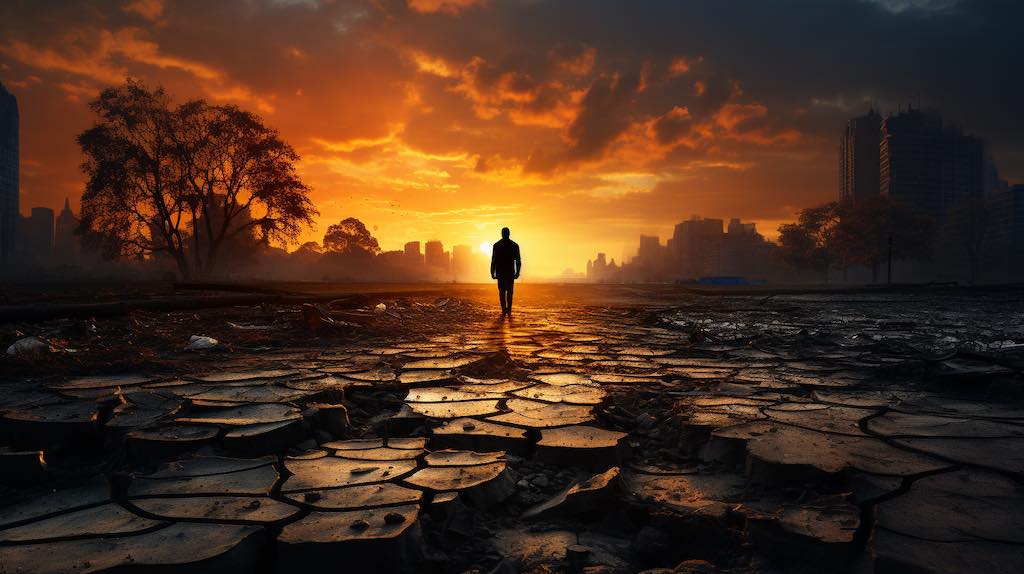Climate change is one of the most pressing issues facing our planet today. It is a global phenomenon with far-reaching consequences for all of us. While the scale of the problem might seem overwhelming, it’s important to remember that even small changes in our daily lives can make a big impact in the fight against climate change. By understanding the science behind climate change, recognizing the role of individual action, and implementing small changes with big impacts, we can all contribute to creating a more sustainable future.
Understanding Climate Change
Climate change is a complex and pressing issue that has captured the attention of scientists, policymakers, and individuals around the world. It is a phenomenon that is primarily caused by the increase in greenhouse gas emissions, such as carbon dioxide, methane, and nitrous oxide. These gases, often referred to as greenhouse gases, trap heat in the Earth’s atmosphere, leading to a rise in global temperatures.
The burning of fossil fuels for energy production, transportation, and industrial processes is a significant contributor to greenhouse gas emissions. As our demand for energy continues to grow, so does the release of these gases into the atmosphere. Additionally, deforestation and land use changes also play a role in climate change. Trees and plants absorb carbon dioxide from the atmosphere, acting as natural carbon sinks. However, when forests are cleared for agriculture, urbanization, or logging, this natural process is disrupted, leading to an increase in greenhouse gas levels.
The Science Behind Climate Change
To fully comprehend the science behind climate change, it is important to understand the concept of the greenhouse effect. The Earth’s atmosphere acts like a blanket, allowing sunlight to enter but trapping some of the heat that is radiated back from the Earth’s surface. This natural process is essential for maintaining a habitable climate on our planet. However, human activities have intensified the greenhouse effect by releasing excessive amounts of greenhouse gases into the atmosphere.
As these greenhouse gases accumulate, they create a thicker blanket around the Earth, trapping more heat and causing the planet to warm up. This phenomenon, known as global warming, is the primary driver of climate change. The consequences of global warming extend far beyond just rising temperatures.
The Global Impact of Climate Change
The effects of climate change are not limited to rising temperatures alone. They have far-reaching and profound impacts on various aspects of our planet. One of the most noticeable consequences is the increase in the frequency and severity of natural disasters. Hurricanes, droughts, floods, and wildfires are becoming more intense and destructive, posing a significant threat to human lives, infrastructure, and ecosystems.
Rising sea levels are another consequence of climate change that poses a grave risk to coastal areas and island nations. As temperatures rise, glaciers and ice caps melt, adding more water to the oceans. This leads to the inundation of low-lying coastal regions, erosion of shorelines, and the loss of critical habitats. Small island nations, already vulnerable to the impacts of climate change, are particularly at risk of being submerged by rising sea levels.
Changes in precipitation patterns are also a result of climate change, with some areas experiencing more frequent and intense rainfall while others suffer from prolonged droughts. These shifts in rainfall patterns have significant implications for agriculture and water supplies. Crop yields may decline, leading to food shortages and price hikes, while water scarcity becomes an increasing concern for both human consumption and ecosystem health.
Furthermore, climate change poses a severe threat to biodiversity and ecosystem health. Rising temperatures and changing environmental conditions disrupt ecosystems, leading to the loss of species and degradation of habitats. This loss of biodiversity not only impacts the natural world but also has far-reaching consequences for human societies, as healthy ecosystems provide crucial services such as clean air, water, and food.
In conclusion, climate change is a multifaceted issue with wide-ranging impacts. It is caused primarily by the increase in greenhouse gas emissions, driven by human activities such as burning fossil fuels and deforestation. The consequences of climate change extend beyond rising temperatures and include more frequent and severe natural disasters, rising sea levels, changes in precipitation patterns, and biodiversity loss. Addressing climate change requires global cooperation and concerted efforts to reduce greenhouse gas emissions, transition to renewable energy sources, and protect and restore ecosystems.
The Role of Individual Action in Combating Climate Change
Why Individual Action Matters
Individual actions may seem insignificant compared to the scale of the problem, but they add up. Each individual has the power to reduce their carbon footprint and influence others to do the same through their choices and behaviors. Collectively, individual actions can lead to significant reductions in greenhouse gas emissions and create a demand for sustainable solutions from governments and businesses.
One example of how individual action can make a difference is through energy conservation at home. By making simple changes such as switching to energy-efficient light bulbs, insulating their homes, and using appliances wisely, individuals can reduce their energy consumption and lower their carbon emissions. These small actions, when multiplied by millions of households, can have a substantial impact on overall energy usage and greenhouse gas emissions.
Another area where individual action plays a crucial role is in promoting sustainable transportation options. By choosing to walk, bike, or use public transportation instead of driving alone in a car, individuals can significantly reduce their carbon footprint. Additionally, advocating for the development of bike lanes, pedestrian-friendly infrastructure, and efficient public transportation systems can encourage more people to adopt sustainable transportation habits.
Case Studies of Effective Individual Actions
There are many inspiring examples of individuals making a difference in the fight against climate change. From reducing energy consumption and adopting renewable energy sources at home to promoting sustainable transportation options and advocating for policy changes, these individuals demonstrate that small actions can have remarkable impacts.
One notable case study is that of Sarah, a homeowner who decided to install solar panels on her roof. By generating her own clean energy, Sarah not only reduced her reliance on fossil fuels but also inspired her neighbors to follow suit. As a result, several homes in her community now have solar panels, collectively reducing the neighborhood’s carbon emissions and contributing to a cleaner environment.
In another case, John, a passionate advocate for sustainable transportation, started a grassroots campaign to raise awareness about the benefits of biking. Through his efforts, he successfully lobbied local authorities to invest in bike lanes and improve cycling infrastructure. As a result, more people in his city now choose to bike instead of drive, leading to a decrease in traffic congestion and air pollution.
These case studies highlight the power of individual action in creating a ripple effect of positive change. By taking responsibility for their own carbon footprint and inspiring others to do the same, individuals can play a significant role in combatting climate change.
Small Changes with Big Impacts
Energy Efficiency at Home
Improving energy efficiency at home is one of the most effective ways to reduce greenhouse gas emissions. Simple actions such as switching to energy-efficient appliances, insulating homes, and using programmable thermostats can significantly reduce energy consumption and lower electricity bills.
When it comes to energy-efficient appliances, there are many options available in the market. From refrigerators and washing machines to air conditioners and light bulbs, manufacturers have been investing in developing products that consume less energy without compromising on performance. By replacing old, energy-guzzling appliances with these new models, homeowners can not only save money on their electricity bills but also contribute to a greener environment.
Insulating homes is another effective way to improve energy efficiency. Proper insulation helps to keep the indoor temperature stable, reducing the need for heating or cooling. This not only saves energy but also enhances the comfort level of the residents. Insulation materials such as fiberglass, cellulose, and foam can be used in walls, attics, and basements to prevent heat loss or gain.
In addition to energy-efficient appliances and insulation, using programmable thermostats can also make a significant impact. These thermostats allow homeowners to set different temperature levels for different times of the day, ensuring that energy is not wasted when no one is at home or during sleeping hours. This smart technology helps to optimize energy usage and reduce unnecessary heating or cooling.
Sustainable Transportation Choices
Transportation is a major source of greenhouse gas emissions. Opting for public transportation, carpooling, biking, or walking instead of driving alone can reduce emissions and improve air quality. Investing in electric or hybrid vehicles, or using ride-sharing services that offer low-emission vehicles, are also impactful choices.
Public transportation systems, such as buses, trains, and subways, are designed to accommodate a large number of passengers, reducing the number of individual vehicles on the road. By utilizing these systems, commuters can contribute to reducing traffic congestion and emissions. Additionally, many cities are now implementing bike-sharing programs, making it easier for people to choose biking as a sustainable mode of transportation.
Carpooling is another effective way to reduce emissions. By sharing rides with others who have similar destinations, individuals can significantly reduce the number of vehicles on the road. This not only helps to reduce greenhouse gas emissions but also saves money on fuel and parking expenses.
Investing in electric or hybrid vehicles is a long-term solution for sustainable transportation. These vehicles produce lower or zero emissions compared to traditional gasoline-powered cars. With advancements in technology, electric vehicles are becoming more affordable and accessible to a wider range of consumers. Ride-sharing services that offer low-emission vehicles also provide an alternative to traditional car ownership, allowing individuals to contribute to reducing emissions without the need to own a vehicle.
Conscious Consumption and Waste Reduction
Consumer choices play a significant role in driving demand for sustainable products and reducing waste. Choosing products with minimal packaging, avoiding single-use plastics, and recycling or composting waste are simple yet powerful ways to contribute to a more circular economy.
When shopping, consumers can look for products that have minimal packaging or packaging made from recycled materials. This reduces the amount of waste generated and the resources required for production. Additionally, opting for products that can be reused or refilled, such as water bottles or cleaning supplies, helps to minimize the consumption of single-use plastics.
Recycling and composting are essential practices for waste reduction. By separating recyclable materials from general waste and ensuring they are properly recycled, valuable resources can be recovered and reused. Composting organic waste, such as food scraps and yard trimmings, not only reduces the amount of waste sent to landfills but also produces nutrient-rich soil that can be used for gardening or landscaping.
Furthermore, consumers can support businesses and brands that prioritize sustainability and waste reduction. By choosing to buy from companies that have implemented environmentally friendly practices, consumers can send a strong message to the market and encourage more businesses to adopt sustainable approaches.
Overcoming Barriers to Individual Action
Psychological Barriers and How to Overcome Them
Many individuals may feel overwhelmed or powerless when confronted with the magnitude of climate change. It’s important to address these psychological barriers by promoting awareness, providing accessible information, and offering practical solutions. Empowering individuals to take action and emphasizing the positive impact of their choices can help overcome these barriers.
One of the psychological barriers that individuals often face is the feeling of insignificance in the face of such a global issue. Climate change is a complex problem that requires collective action, but it is essential to remember that every small action counts. By educating individuals about the cumulative effect of their choices, we can empower them to make a difference. For example, switching to energy-efficient light bulbs may seem like a small step, but when millions of people make the same choice, it can have a significant impact on reducing greenhouse gas emissions.
Another psychological barrier is the fear of judgment or criticism from others. Taking action on climate change can sometimes be seen as inconvenient or even radical. To overcome this barrier, it is crucial to create a supportive and inclusive environment where individuals feel comfortable expressing their concerns and ideas. By fostering a sense of community and highlighting the positive actions of others, we can inspire more people to join the movement.
Practical Barriers and Solutions
Practical barriers, such as cost or lack of infrastructure, can also hinder individual action. Governments, businesses, and communities need to work together to address these barriers by providing incentives, improving accessibility to sustainable options, and investing in renewable energy infrastructure. Collaboration and innovation are key to finding solutions that make sustainable choices more accessible and affordable for everyone.
One practical barrier that individuals often encounter is the higher cost associated with sustainable products or services. While it is true that some eco-friendly options may have a higher upfront cost, it is essential to consider the long-term benefits and savings they can provide. For instance, investing in solar panels may require a significant initial investment, but it can lead to substantial savings on electricity bills in the long run. By educating individuals about the economic advantages of sustainable choices, we can encourage them to overcome this barrier.
Lack of infrastructure is another practical barrier that can hinder individual action. For example, individuals living in areas without proper recycling facilities may find it challenging to dispose of their waste responsibly. To address this issue, communities can work towards improving recycling infrastructure and implementing effective waste management systems. By providing accessible solutions, such as community recycling centers or collection points, individuals can overcome this barrier and actively participate in sustainable practices.
In conclusion, overcoming barriers to individual action on climate change requires addressing both psychological and practical obstacles. By promoting awareness, empowering individuals, and providing accessible solutions, we can create a collective movement towards a more sustainable future. It is through collaboration and innovation that we can overcome these barriers and inspire meaningful change.
The Future of Climate Change and Individual Action
Emerging Trends in Individual Climate Action
As awareness of climate change grows, we are witnessing a surge in individual climate action. From grassroots movements demanding change to technological advancements that enable sustainable lifestyles, individuals are increasingly mobilizing and using their voices to drive meaningful change.
One emerging trend in individual climate action is the rise of community-led initiatives. People are coming together to form local groups that focus on sustainability and environmental stewardship. These groups organize events such as community clean-ups, tree planting campaigns, and educational workshops to raise awareness and inspire others to take action. By building a sense of community around climate change, individuals are creating a support network that fosters motivation and accountability.
Another trend is the increasing use of technology to track and reduce carbon footprints. Mobile applications and online platforms are empowering individuals to monitor their energy consumption, transportation choices, and waste generation. These tools provide real-time data and personalized recommendations, enabling individuals to make informed decisions and track their progress towards reducing their environmental impact.
The Power of Collective Individual Action
Collective individual action has the potential to create a ripple effect, inspiring others to take action and advocating for systemic changes. By engaging in conversations, influencing policy, supporting sustainable businesses, and fostering a culture of sustainability, we can create a future where individual actions are the norm rather than the exception.
One example of collective individual action is the growing movement of “green cities.” These are cities that prioritize sustainability and actively work towards reducing their carbon footprint. Through the collective efforts of individuals, businesses, and local governments, green cities implement policies and infrastructure that promote renewable energy, sustainable transportation, and waste reduction. By showcasing the benefits of sustainable living, green cities inspire other communities to follow suit.
Another powerful form of collective individual action is the divestment movement. This movement encourages individuals and institutions to withdraw their financial support from fossil fuel companies and invest in renewable energy alternatives. By divesting from fossil fuels, individuals send a strong message to the industry and policymakers that they demand a transition to cleaner and more sustainable energy sources.
Climate change is a complex problem that requires collective efforts at all levels. While governments, businesses, and international agreements are crucial in driving systemic change, individual action is equally important. Each one of us has the power to make small changes in our daily lives that collectively can make a big impact. By understanding the science, recognizing the role of individual action, implementing small changes, and overcoming barriers, we can all be part of the solution. Together, let’s create a more sustainable and resilient future for generations to come.
One way individuals can contribute to the fight against climate change is by adopting sustainable eating habits. The food we consume plays a significant role in greenhouse gas emissions, deforestation, and water usage. By choosing to eat locally sourced and organic foods, reducing meat consumption, and avoiding food waste, individuals can significantly reduce their carbon footprint and contribute to a more sustainable food system.
Another area where individual action can make a difference is in sustainable transportation. By opting for public transportation, biking, or carpooling, individuals can reduce their carbon emissions and alleviate traffic congestion. Additionally, the adoption of electric vehicles and the development of charging infrastructure are crucial steps towards a greener transportation system.
Furthermore, individuals can make a positive impact by supporting sustainable businesses. By choosing to buy products from companies that prioritize environmental sustainability, fair trade practices, and ethical sourcing, individuals can influence the market and drive demand for more sustainable products and services. Additionally, individuals can also support local businesses, which often have a smaller environmental footprint compared to large corporations.
Overcoming barriers to individual climate action is essential for creating lasting change. Lack of awareness, perceived inconvenience, and financial constraints are common barriers that individuals face. Education and awareness campaigns can help address these barriers by providing information and resources to empower individuals to take action. Governments and organizations can also play a role by implementing policies and incentives that make sustainable choices more accessible and affordable for all.
By embracing the power of collective individual action, we can create a future where sustainability is at the forefront of decision-making. Let’s continue to raise our voices, inspire others, and work together towards a more sustainable and resilient planet.








































